Cattle Welfare Assessment
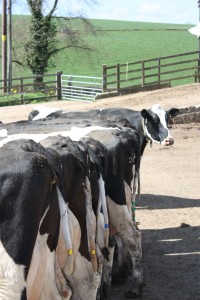 Awareness, promotion and achieving high standards of animal welfare should always be a key priority within sustainable livestock practices. Gaining an understanding of an animal’s behavioral and physiological needs are cornerstones that enable us to develop systems of production that promote positive welfare. But how do we go about measuring welfare so that we can understand the strengths and weaknesses of a system and to continuously improve? Visit our Welfare Assessment page in the Veterinary Questions section for more information on the principles of assessment.
Awareness, promotion and achieving high standards of animal welfare should always be a key priority within sustainable livestock practices. Gaining an understanding of an animal’s behavioral and physiological needs are cornerstones that enable us to develop systems of production that promote positive welfare. But how do we go about measuring welfare so that we can understand the strengths and weaknesses of a system and to continuously improve? Visit our Welfare Assessment page in the Veterinary Questions section for more information on the principles of assessment.
So How Do We Measure Cow Welfare?
The measures listed below have been identified by AssureWel as being important indicators of dairy cow welfare. The criteria to select these ‘core’ measures include consideration as to how practical they are to assess on-farm.
Lameness and Mobility
Lameness is known to be a huge welfare issue that significantly affects the welfare of the cow (Whay et al., 2003) and can have major financial implications. Although cows’ milk production starts to decline even before their mobility is visibly impaired (Reader et al., 2011), early detection and prompt treatment significantly reduce yield losses (Archer et al., 2010a). Levels and severity of lameness should be regularly assessed using mobility scoring. Mobility scoring refers to a structured subjective system for the assessment of a cow’s gait, designed to reduce variations between observers (Archer et al., 2010b). More information on Lameness and the DairyCo Mobility Score.
Nutrition and Body Condition
Body condition varies considerably during a cow’s lactation. Body condition scoring (BCS) is an important farm management tool, helping to monitor the energy reserve of a cow and aiding management decisions throughout the lactation. Scoring involves an assessment of the relative amount of fat cover at regular intervals and an evaluation of whether this falls within acceptable levels according to stage of lactation and breeding. The scale used to measure BCS differs between countries, but low values always reflect emaciation and high values equate to obesity (Roche et al., 2009).
Cleanliness and Hygiene
Cleanliness assessments involve recording levels of dirtiness around various parts of the body. Cows prefer to lie and rest in clean areas and show a clear preference for a dry lying surface – they spend much more time standing outside stalls when only wet bedding is available (Fregonesi et al., 2007). Animals covered in mud and or feces is indicative of a potential welfare problem related to poor management and housing (e.g. Bowell et al., 2003; Zurbrigg et al., 2005; Norring et al., 2008) and can be associated with ill health as well as presenting disease risks, including mastitis (Ellis et al., 2007).
Hair loss, lesions and swellings
The presence, location and extent of hair loss, lesions and swellings can be indicative of poor housing, aggression, the presence of external parasites and injury. For example, for tied animals, stall design is strongly linked to the presence or absence of lesions (Zurbrigg et al., 2005) and bedding material (mats versus mattresses) in cubicle housing (Livesey et al., 2002).
Broken tails
The proportion of cows with broken tails is associated directly with either current or historical negative welfare events within a herd. The incidence of broken tails has also been associated with other welfare factors. For example, it has been shown that the prevalence of broken tails is associated with the prevalence of dirty udders (Zurbrigg et al., 2005).
Response to Stockperson
There is a well-established link between attitudes, behavior and handling methods of those working with cattle and cattle welfare and production i.e. the human-animal relationship (Hemsworth in Benson and Hemsworth and Coleman, 2011, Rushen et al., 1999; Breuer et al., 2000). Cattle fearful of humans are also at a greater risk of injury during handling.
Animals Needing Further Care
Cows that are sick/injured and are not receiving adequate attention are likely to suffer pain, discomfort and distress. While there are sound economic reasons for ensuring animals receive treatment enabling them to recover, there are also moral and legal imperatives to provide for animals needing further care. Care not only constitutes appropriate treatment, but also management, such as isolation and protection from others when necessary, providing clean and comfortable bedding, easy access to feed and water and other physical aids that enable comfort and recovery. It is possible, as part of the assessment of welfare, to measure the extent that animals require care by keeping and examining records of veterinary treatments.
Mastitis
Mastitis is one of the most prevalent health conditions in dairy cattle and is hence of considerable welfare concern. It is also a very painful condition that in most cases is preventable. Mastitis monitoring as a welfare measure is relatively easy in most dairy herds. Visit the mastitis pages for more information on mastitis and its control.
Calf/Heifer Survivability
Approximately 8% of dairy calves are stillborn and 15% of live heifers either die or are culled before they have their first calf (Lombard et al., 2007; Brickell et al., 2009). This represents both a significant economic loss and welfare concern. There are a wide range of health and welfare reasons for these deaths and their occurrence can be indicative of more widespread welfare issues within a dairy herd. Relatively simple interventions have the potential to significantly reduce the impact of dystocia and improve calf and heifer survivability.
Cull and Casualty Cows
Culling of cows from a herd can be both voluntary, as a planned economic and/or management decision, or involuntary/casualty resulting from an unplanned health event, such as an injury or lameness. For both welfare and economic reasons, cows should ideally have longevity within a herd. Monitoring the number of culls and casualties and reasons for both planned and unplanned culling provides an indicator of herd health and welfare status and also a useful management tool to identify areas for improvement.
Guidance on Welfare Assessment
The AssureWel project has provided Assessment Protocols, or guidance, on how to undertake all of the welfare measures listed above as well as Assessment Score Sheets which allow recording of each of the measures. A full Explanation of the Measures can also be found at www.assurewel.org/dairycows.
Resource or Input Based Measures
Input or resource based welfare assessments include assessing the environment such as housing (e.g. bedding type), animal aspects (e.g. stocking density and nutrition), and human aspects (e.g. cleaning regime). These factors are often easy to quantify and record and are repeatable (Whay et al., 2003), and although they do not guarantee good welfare, they should be a pre-requisite for good welfare (Johnsen et al, 2001).
Various schemes have been developed to index assessments of welfare-related inputs and these have been used for quality assurance and certification purposes. They are based on a list of parameters for which the presence/absence /degree is given a numerical rating or weighting. An overall total provides a measure of welfare which can be compared with minimum, target or threshold totals e.g. ANI 35L, TGI 200 and ALD There is a risk when using such an approach that some low scores may be balanced by high scores and therefore the weighting process is critical with sufficient emphasis on the important parameters (Aerts, 2006) and minimum standards set to prevent over-compensation (Spoolder et al., 2003). Although welfare indices are viewed as simple and practical, systematic tool, based on scientific literature and demonstrating high repeatability (Spoolder et al., 2003), they do not incorporate animal based parameters (Hörning, 2001).
Examples of Other Welfare Assessment Tools
The Animal Needs Index (ANI) or Tiegerechtheitsindex (TGI) were developed and used in Austria on housed animals for many years as both a marketing and legislation tool (Bartussek, 2000). A refined version, the ANI 35L, was used in Austrian organic certification since 1995. The system includes measures associated with possibility of mobility, social contact, floor condition, indoor climate and quality of human care (Bartussek, 2001). An adaptation, the TGI 200, is used in organic farming in Germany (Bennedsgaard & Thamsborg, 2000) and is based on measures of locomotion, feeding, social behaviour, resting, comfort, hygiene and human care) as well as some behavioral assessments.
Other input based systems include the Assessment scheme for loose Litter housing systems of Dairy cows (ALD) (Hörning, 2001) and the Five Freedoms Index for loose-housed dairy cattle (Capdeville & Veissier, 2001). In Norway, the Organic Cow Comfort advisory tool has been developed to ensure high animal welfare on organic dairy farms by focusing on advice and creating a positive dialogue between farmer, vet and advisor (Henriksen et al, 2006).
The Ethical Account for Livestock Farming was developed solely for use as an advisory tool incorporating indicators of the system, system applications, behavior and diseases and although technically successful, has proved to be too costly and time-consuming for practical application (Jensen and Sørensen, 2001).
Benchmarking
Benchmarking enables comparison between similar groups and provides indicators of what is achievable. This method of monitoring and surveillance can be applied to animal welfare assessments. The use of benchmarking within organic certification has been proposed whereby a suitable system could benefit the producer (to identify strengths and weaknesses), for certification (monitoring and highlighting risk areas) and for consumers (welfare quality assurance) (Main et al., 2001 & Main et al., 2003; Huxley et al., 2004 and University of Bristol, 2004).
Experience suggests that when comparative assessments of welfare outcomes are undertaken that farms tend not to perform consistently well or consistently badly across a range of measurements and that each farm has strengths and weaknesses in relation to the measured indices of the cows’ welfare (Whay et al., 2003). Participating in herd welfare assessments can be a valuable experience for farmers, raising awareness and inspiring change, although there are also likely to be negative feelings, particularly if the assessment measures are not clearly understood (Burke and Roderick, 2006) and frustrations associated with financial restrictions limiting changes to welfare inputs (Burke, 2006).
Welfare Quality
The Welfare Quality Project was a large EU research program designed to develop European standards for on-farm welfare assessment and product information systems as well as practical strategies for improving animal welfare (Blokhuis et al., 2013). The project published a large quantity of material reflecting the results from numerous research studies. A selection of some of the popular publications relevant to cattle keepers are provided below:


 British English
British English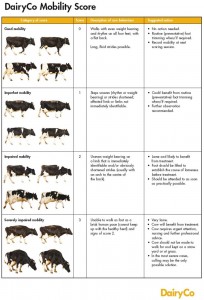
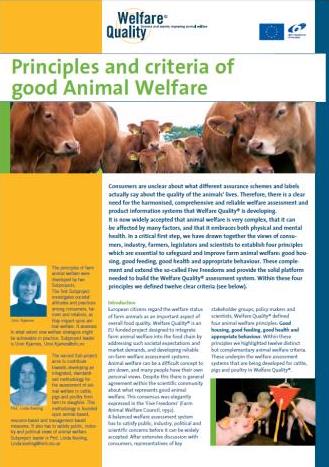
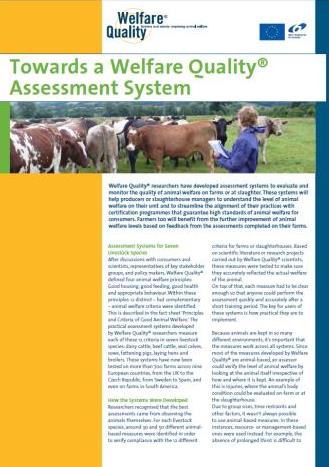
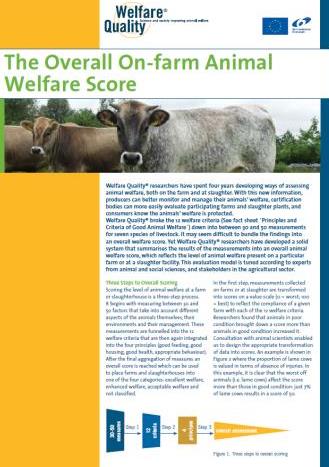
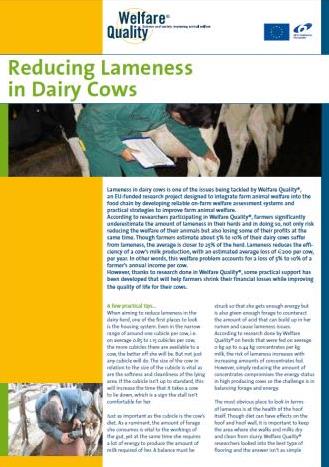
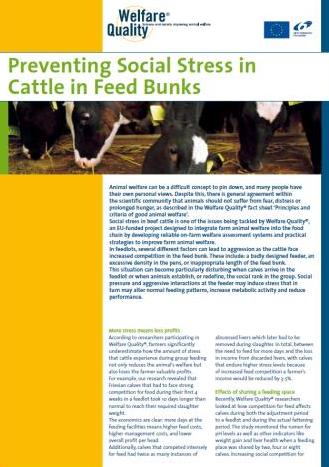
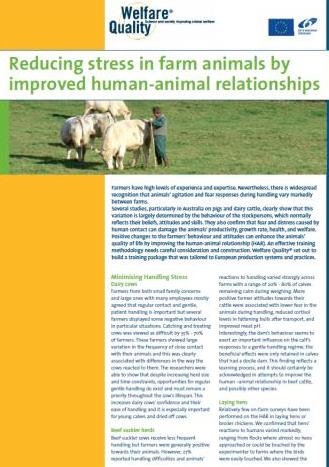


Comments are closed.